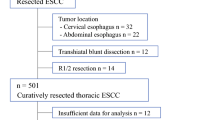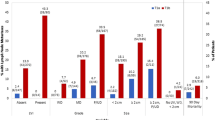Abstract
Purpose
Esophagectomy for esophageal cancer has a high incidence rate of early postoperative recurrence and death. This study aimed to identify the clinical and pathological features in early recurrence cases and to confirm the usefulness of prediction using these factors for effective adjuvant therapy and postoperative surveillance.
Methods
One hundred and twenty five patients who developed postoperative recurrence after undergoing radical esophagectomy for thoracic esophageal cancer were classified into two groups as follows: those with early recurrence at ≤ 6 months and those with nonearly recurrence at > 6 months after surgery. After identifying related factors of early recurrence, usefulness of these factors for prediction were examined in all patients with and without recurrence.
Results
The analysis cohort consisted of 43 and 82 patients in the early and nonearly recurrence groups, respectively. In multivariate analysis, factors associated with early recurrence were higher initial levels of tumor markers (squamous cell carcinoma [SCC] ≥ 1.5 ng/ml in tumors, except for adenocarcinoma, and carcinoembryonic antigen [CEA] ≥ 5.0 ng/ml in adenocarcinoma) and higher venous invasion (v), i.e., ≥ 2 (p = 0.040 and p = 0.004, respectively). The usefulness of these two factors for recurrence prediction was confirmed in 378 patients, including 253 patients without recurrence. Patients with at least one of the two factors had significantly higher early recurrence rates than those without any factors in pStages II and III (odds ratio [OR], 6.333; p = 0016 and OR, 4.346; p = 0.008, respectively).
Conclusions
Early recurrence of thoracic esophageal cancer (i.e., during ≤ 6 months after esophagectomy) was associated with higher initial tumor marker levels and pathological findings of v ≥ 2. The combination of these two factors is useful as a simple and critical predictor of early postoperative recurrence.



Similar content being viewed by others
Data availability
Due to the nature of this research, participants of this study did not agree for their data to be shared publicly, so supporting data is not available.
References
Sung H, Ferlay J, Siegel RL, Laversanne M, Soerjomataram I, Jemal A, et al. Global Cancer Statistics 2020: GLOBOCAN estimates of incidence and mortality worldwide for 36 cancers in 185 countries. CA Cancer J Clin. 2021;71:209–49.
Miyata H, Yamasaki M, Kurokawa Y, Takiguchi S, Nakajima K, Fujiwara Y, et al. Survival factors in patients with recurrence after curative resection of esophageal squamous cell carcinomas. Ann Surg Oncol. 2011;18:3353–61.
Nakamura T, Ota M, Narumiya K, Sato T, Ohki T, Yamamoto M, et al. Multimodal treatment for lymph node recurrence of esophageal carcinoma after curative resection. Ann Surg Oncol. 2008;15:2451–7.
Matsuda S, Kawakubo H, Okamura A, Takahashi K, Toihata T, Takemura R, et al. Distribution of residual disease and recurrence patterns in pathological responders after neoadjuvant chemotherapy for esophageal squamous cell carcinoma. Ann Surg. 2020;276:298–304.
Hamai Y, Emi M, Ibuki Y, Murakami Y, Nishibuchi I, Nagata Y, et al. Early recurrence and cancer death after trimodal therapy for esophageal squamous cell carcinoma. Anticancer Res. 2019;39:1433–40.
Kelly RJ, Ajani JA, Kuzdzal J, Zander T, Van Cutsem E, Piessen G, et al. Adjuvant nivolumab in resected esophageal or gastroesophageal junction cancer. N Engl J Med. 2021;384:1191–203.
Smyth EC, Gambardella V, Cervantes A, Fleitas T. Checkpoint inhibitors for gastroesophageal cancers: dissecting heterogeneity to better understand their role in first-line and adjuvant therapy. Ann Oncol. 2021;32:590–9.
Davies AR, Pillai A, Sinha P, Sandhu H, Adeniran A, Mattsson F, et al. Factors associated with early recurrence and death after esophagectomy for cancer. J Surg Oncol. 2014;109:459–64.
Lerut T, Moons J, Coosemans W, Van Raemdonck D, De Leyn P, Decaluwe H, et al. Postoperative complications after transthoracic esophagectomy for cancer of the esophagus and gastroesophageal junction are correlated with early cancer recurrence: role of systematic grading of complications using the modified Clavien classification. Ann Surg. 2009;250:798–807.
Stiles BM, Salzler GG, Nasar A, Paul S, Lee PC, Port JL, et al. Clinical predictors of early cancer-related mortality following neoadjuvant therapy and oesophagectomy. Eur J Cardiothorac Surg. 2015;48:455–60 (discussion 60-1).
Brierley J, Gospodarowicz MK, Wittekind C. TNM classification of malignant tumours. 8th ed. Chichester: Wiley; 2017.
Japan ES. Japanese classification of esophageal cancer, 11th Edition: part I. Esophagus. 2017;14:1–36.
Dindo D, Demartines N, Clavien PA. Classification of surgical complications: a new proposal with evaluation in a cohort of 6336 patients and results of a survey. Ann Surg. 2004;240:205–13.
Yoshida N, Baba Y, Shigaki H, Harada K, Iwatsuki M, Sakamoto Y, et al. Risk factors of early recurrence within 6 months after esophagectomy following neoadjuvant chemotherapy for resectable advanced esophageal squamous cell carcinoma. Int J Clin Oncol. 2016;21:1071–8.
Lindenmann J, Fediuk M, Fink-Neuboeck N, Porubsky C, Pichler M, Brcic L, et al. Hazard curves for tumor recurrence and tumor-related death following esophagectomy for esophageal cancer. Cancers (Basel). 2020;12:2066.
Kosugi S, Kanda T, Yajima K, Ishikawa T, Hatakeyama K. Risk factors that influence early death due to cancer recurrence after extended radical esophagectomy with three-field lymph node dissection. Ann Surg Oncol. 2011;18:2961–7.
Kanda M, Koike M, Shimizu D, Tanaka C, Kobayashi D, Hattori N, et al. Optimized cutoff value of serum squamous cell carcinoma antigen concentration accurately predicts recurrence after curative resection of squamous cell carcinoma of the esophagus. Ann Surg Oncol. 2020;27:1233–40.
Maehara Y, Kabashima A, Koga T, Tokunaga E, Takeuchi H, Kakeji Y, et al. Vascular invasion and potential for tumor angiogenesis and metastasis in gastric carcinoma. Surgery. 2000;128:408–16.
Takeuchi A, Ojima T, Katsuda M, Hayata K, Goda T, Kitadani J, et al. Venous invasion is a risk factor for recurrence of pT1 gastric cancer with lymph node metastasis. J Gastrointest Surg. 2022;26:757–63.
Nishibeppu K, Komatsu S, Ichikawa D, Imamura T, Kosuga T, Okamoto K, et al. Venous invasion as a risk factor for recurrence after gastrectomy followed by chemotherapy for stage III gastric cancer. BMC Cancer. 2018;18:108.
Jeon JH, Lee JM, Moon DH, Yang HC, Kim MS, Lee GK, et al. Prognostic significance of venous invasion and maximum standardized uptake value of (18)F-FDG PET/CT in surgically resected T1N0 esophageal squamous cell carcinoma. Eur J Surg Oncol. 2017;43:471–7.
Zhu ZJ, Hu Y, Zhao YF, Chen XZ, Chen LQ, Chen YT. Early recurrence and death after esophagectomy in patients with esophageal squamous cell carcinoma. Ann Thorac Surg. 2011;91:1502–8.
Hiyoshi Y, Yoshida N, Watanabe M, Kurashige J, Karashima R, Iwagami S, et al. Late recurrence after radical resection of esophageal cancer. World J Surg. 2016;40:913–20.
Matsuda S, Kawakubo H, Okamura A, Takahashi K, Toihata T, Takemura R, et al. Prognostic significance of stratification using pathological stage and response to neoadjuvant chemotherapy for esophageal squamous cell carcinoma. Ann Surg Oncol. 2021;28:8438–47.
Hashimoto T, Makino T, Yamasaki M, Tanaka K, Miyazaki Y, Takahashi T, et al. The pattern of residual tumor after neoadjuvant chemotherapy for locally advanced esophageal cancer and its clinical significance. Ann Surg. 2020;271:875–84.
Kitagawa Y, Uno T, Oyama T, Kato K, Kato H, Kawakubo H, et al. Esophageal cancer practice guidelines 2017 edited by the Japan Esophageal Society: part 1. Esophagus. 2019;16:1–24.
Kudou M, Shiozaki A, Fujiwara H, Konishi H, Arita T, Kosuga T, et al. Efficacy of PET-CT in the diagnosis and treatment of recurrence after esophageal cancer surgery. Anticancer Res. 2016;36:5473–80.
Kim SJ, Hyun SH, Moon SH, Lee KS, Sun JM, Oh D, et al. Diagnostic value of surveillance (18)F-fluorodeoxyglucose PET/CT for detecting recurrent esophageal carcinoma after curative treatment. Eur J Nucl Med Mol Imaging. 2019;46:1850–8.
Ueda M, Iguchi T, Masuda T, Nakahara Y, Hirata H, Uchi R, et al. Somatic mutations in plasma cell-free DNA are diagnostic markers for esophageal squamous cell carcinoma recurrence. Oncotarget. 2016;7:62280–91.
Ococks E, Frankell AM, Masque Soler N, Grehan N, Northrop A, Coles H, et al. Longitudinal tracking of 97 esophageal adenocarcinomas using liquid biopsy sampling. Ann Oncol. 2021;32:522–32.
Rahman SA, Walker RC, Lloyd MA, Grace BL, van Boxel GI, Kingma BF, et al. Machine learning to predict early recurrence after oesophageal cancer surgery. Br J Surg. 2020;107:1042–52.
Huang S, Yang J, Fong S, Zhao Q. Artificial intelligence in cancer diagnosis and prognosis: opportunities and challenges. Cancer Lett. 2020;471:61–71.
Strom P, Kartasalo K, Olsson H, Solorzano L, Delahunt B, Berney DM, et al. Artificial intelligence for diagnosis and grading of prostate cancer in biopsies: a population-based, diagnostic study. Lancet Oncol. 2020;21:222–32.
Mamdani H, Schneider B, Perkins SM, Burney HN, Kasi PM, Abushahin LI, et al. A phase II trial of adjuvant durvalumab following trimodality therapy for locally advanced esophageal and gastroesophageal junction adenocarcinoma: a big ten cancer research consortium study. Front Oncol. 2021;11: 736620.
Qin RQ, Wen YS, Wang WP, Xi KX, Yu XY, Zhang LJ. The role of postoperative adjuvant chemotherapy for lymph node-positive esophageal squamous cell carcinoma: a propensity score matching analysis. Med Oncol. 2016;33:31.
Lyu X, Huang J, Mao Y, Liu Y, Feng Q, Shao K, et al. Adjuvant chemotherapy after esophagectomy: is there a role in the treatment of the lymph node positive thoracic esophageal squamous cell carcinoma? J Surg Oncol. 2014;110:864–8.
van der Kaaij RT, Voncken FEM, van Dieren JM, Snaebjornsson P, Korse CM, Grootscholten C, et al. Elevated pretreatment CEA and CA19-9 levels are related to early treatment failure in esophageal adenocarcinoma. Am J Clin Oncol. 2019;42:345–50.
Kim YH, Ajani JA, Ota DM, Lynch P, Roth JA. Value of serial carcinoembryonic antigen levels in patients with resectable adenocarcinoma of the esophagus and stomach. Cancer. 1995;75:451–6.
Acknowledgements
The authors thank Kumiko Motooka, a staff member at the Department of Surgery in Keio University School of Medicine, for help in the preparation of the manuscript.
Funding
Funding was provided by Taiho Pharmaceutical, Chugai Pharmaceutical, Yakult Honsha, Daiichi-Sankyo, Merck Serono Co., Ltd., Asahi Kasei Co., Ltd., EA Pharma Co., Ltd., Otsuka Pharmaceutical, Takeda Pharmaceutical Company, Otsuka Pharmaceutical Factory Inc., Shionogi, Kaken Pharmaceutical Co., Ltd., Kowa Pharmaceutical Co., Ltd., Astellas Pharma, Medicon Inc., Dainippon Sumitomo Pharma, Taisho Toyama Pharmaceutical Company, Kyowa Hakko Kirin, Pfizer Japan Inc., Ono Pharmaceutical, Nihon Pharmaceutical Co., Ltd., Japan Blood Products Organization, Medtronic Japan Co., Ltd., Sanofi K.K., Eisai, Tsumura and Company, KCI Licensing Inc., Abbott Japan, Fujifilm Toyama Chemical Co., Ltd.
Author information
Authors and Affiliations
Corresponding author
Ethics declarations
Ethical Statement
All procedures were in accordance with the ethical standards of the responsible committee on human experimentation and with the Helsinki Declaration of 1964 and later versions.
Conflict of interest
Yuko Kitagawa received grants from Taiho Pharmaceutical Co., Ltd.; Chugai Pharmaceutical Co., Ltd.; Yakult Honsha Co., Ltd.; Daiichi Sankyo; Merck Serono Co., Ltd.; Asahi Kasei Co., Ltd.; EA Pharma Co., Ltd.; Otsuka Pharmaceutical Co., Ltd.; Takeda Pharmaceutical Co., Ltd.; Otsuka Pharmaceutical Factory Inc.; Shionogi & Co., Ltd.; Kaken Pharmaceutical Co., Ltd.; Kowa Pharmaceutical Co., Ltd.; Astellas Pharma Inc.; Medicon Inc.; Dainippon Sumitomo Pharma Co., Ltd.; Taisho Toyama Pharmaceutical Co., Ltd.; Kyowa Hakko Kirin Co., Ltd.; Pfizer Japan Inc.; Ono Pharmaceutical Co., Ltd.; Nihon Pharmaceutical Co., Ltd.; Japan Blood Products Organization; Medtronic Japan Co., Ltd.; Sanofi K.K.; Eisai Co., Ltd.; Tsumura & Co.; KCI Licensing Inc.; Abbott Japan Co., Ltd.; and Fujifilm Toyama Chemical Co., Ltd. outside the submitted work. Kazuaki Matsui, Hirofumi Kawakubo, Satoru Matsuda, Yuki Hirata, Tomoyuki Irino, Kazumasa Fukuda, Rieko Nakamura, and Hajime Okita declare no conflicts of interest.
Additional information
Publisher's Note
Springer Nature remains neutral with regard to jurisdictional claims in published maps and institutional affiliations.
Supplementary Information
Below is the link to the electronic supplementary material.
Rights and permissions
Springer Nature or its licensor (e.g. a society or other partner) holds exclusive rights to this article under a publishing agreement with the author(s) or other rightsholder(s); author self-archiving of the accepted manuscript version of this article is solely governed by the terms of such publishing agreement and applicable law.
About this article
Cite this article
Matsui, K., Kawakubo, H., Matsuda, S. et al. Clinical predictors of early postoperative recurrence after radical esophagectomy for thoracic esophageal cancer. Esophagus 20, 679–690 (2023). https://doi.org/10.1007/s10388-023-01014-y
Received:
Accepted:
Published:
Issue Date:
DOI: https://doi.org/10.1007/s10388-023-01014-y




